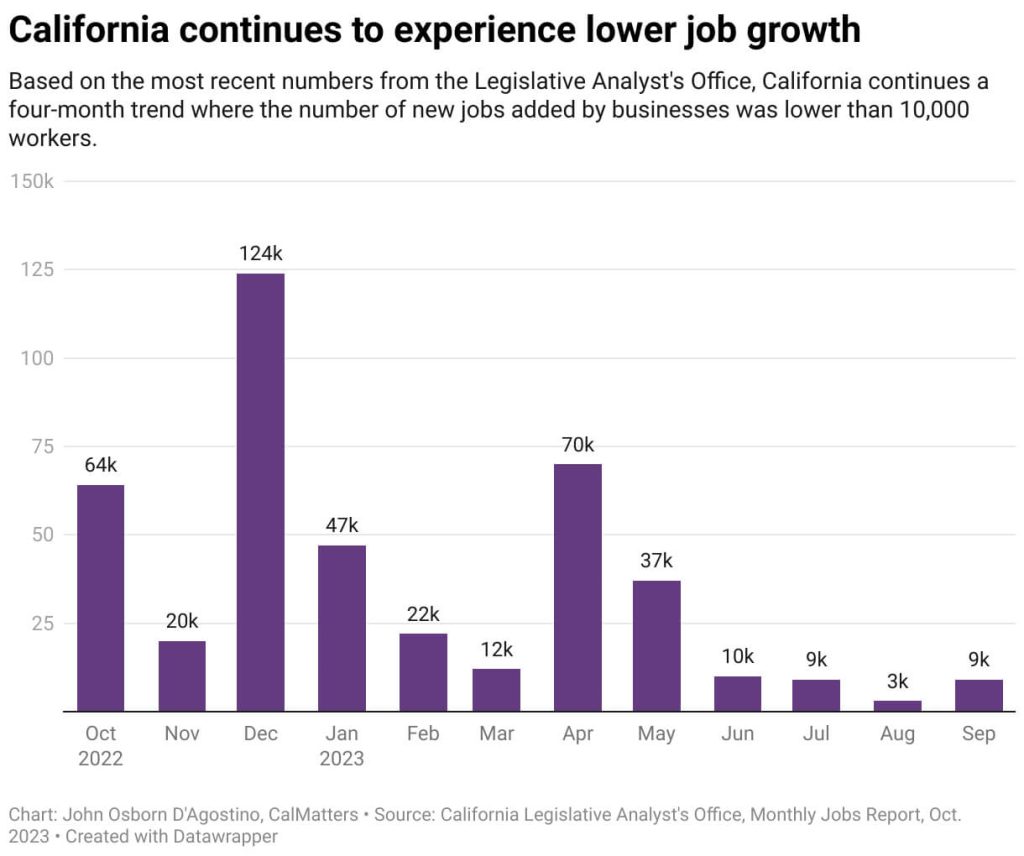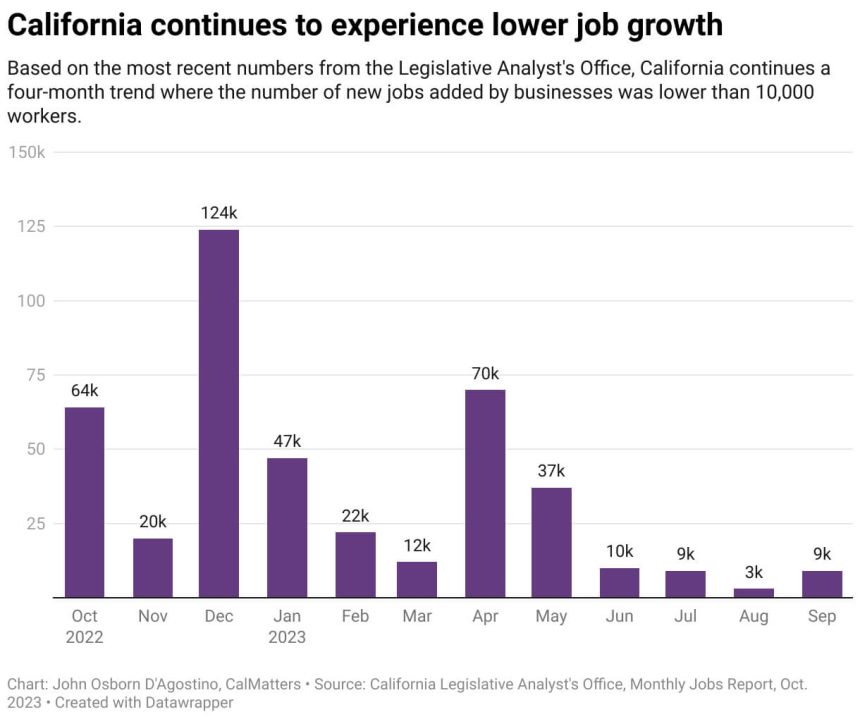Danger Signs for California’s Economy
There are warning signs for the California economy: Unemployment is inching up, tech layoffs continue and IPOs are waning. Experts expect a downturn, but it’s still possible the state will avoid a recession.
By Levi Sumagaysay, CalMatters
California is ending the year facing a multitude of economic challenges, including a budget deficit, flat tax revenue, sluggish job growth and massive unemployment insurance debt.
The state’s budget surplus turned into a $32 billion deficit in 2023 — a result of its heavy reliance on personal income taxes, which are tied to the ups and downs of the stock market. The governor revised the budget in May, shifting money around and delaying spending commitments. In October, the Legislative Analyst’s Office provided an updated outlook, saying the state could see a $9.5 billion boost in revenue due in part to increased income-tax withholding and an improving stock market. But the office still foresees flat revenue from personal income, corporate and sales taxes for the next three years, and a projected $68 billion deficit for the 2024-25 budget.
The state’s unemployment rate, which started the year at 4.2%, had climbed to 4.8% as of October, among the highest in the nation, compared with the U.S. unemployment rate of 3.9%.
Job growth slowed, with the legislative analyst pointing out that as of September, the state had added less than 10,000 jobs four months in a row. The last time that happened was during the Great Recession.
The types of jobs being added and subtracted are key in a state that depends on income-tax revenue. California’s vaunted tech industry continued to shed typically high-wage jobs, with at least 78,000 Golden State-based tech workers laid off for the year, according to Layoffs.fyi, which tracks that information. The jobs that actually grew in the state were in the health sector and in accommodations and food services, with the Public Policy Institute of California noting that those typically pay lower wages.
Another revenue source that has historically helped fill California’s coffers is the initial public offering, which can create immense — and taxable — wealth for executives and employees of newly public companies. After 119 IPOs in the state in 2020 and 195 in 2021, public offerings dropped drastically to 31 last year and 25 this year, according to data from PitchBook, which says the venture capital market remains “under considerable stress” due to economic and geopolitical uncertainty.
One delayed spending commitment as a result of the budget deficit involved addressing the unemployment insurance fund’s $20 billion debt, which ballooned because millions of the state’s residents lost their jobs during the beginning of the pandemic. The debt could compound the state’s financial problems for the next decade, potentially costing $3 billion to $7 billion in interest payments over several years, the legislative analyst projects. The debt also means that employers in California are facing higher required payments into the unemployment insurance fund until it is paid off. Any future instance of mass joblessness and demand for unemployment benefits would mean the state would most likely have to borrow from the federal government again.
California’s population — its labor force — has declined since the COVID-19 pandemic’s onset in 2020, with Wells Fargo economists forecasting that the state’s population probably fell 0.1% in 2023, compared with 0.3% in 2022 and 0.9% in 2021. But in 2024, they expect a 0.2% rise due to increased international migration and people returning to work in the state as remote-work options dwindle.
Experts have varying levels of optimism about the state’s economy, but they agree that California is in for a downturn — a “weak” 2024, as Jerry Nickelsburg, senior economist for the UCLA Anderson Forecast, told CalMatters in October. Nickelsburg noted in a presentation about his forecast, though, that the state’s job growth is weak in certain regions but strong in others, and that despite layoffs, the tech industry is still adding
jobs. Wells Fargo economists, who have been mostly upbeat about the state’s economy, said if there is a nationwide recession next year, the “resilient” state will likely experience a contraction.
Major issues for 2024: The economic challenges California faced in 2023 will be key issues for the state’s lawmakers and governor in 2024. The forecasted budget deficit, flat tax revenue and massive unemployment insurance debt are financial headaches with no quick political cures. Ongoing layoffs and slowdowns in the tech industry and IPOs could also continue to weigh on the state’s bottom line — and so could the possibility that people keep moving out of state. Affordability issues such as rising home and auto insurance premiums, as well as housing costs, are bound to play a role in whether the state’s residents stay.
For More Economic News Visit www.zapinin.com/economy.



